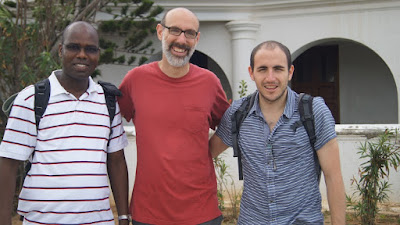This blog post is based on my firsthand experience in Thanjavur District, Tamil Nadu State, South India supported by the Harvard University and IFMR LEAD doctoral fellowship grant. The grant facilitated Thomas Ferreira of Stellenbosch University and myself to spend two weeks in Thanjavur as part of the research exchange program embedded in the Agricultural Technology Adoption Initiative (ATAI)-funded research project. The ATAI-funded project assesses the impact of financial services for the rural poor on agricultural technology adoption. The fellowship was designed to provide an opportunity for PhD students from sub Saharan Africa to acquire first hand experience and learn how the ATAI-funded project was designed, implemented on the ground and what are the expected outputs and outcomes.
 |
|
Harvard University & IFMR LEAD Doctoral Fellows – Emmanuel Sulle (Left), Prof. Christopher Robert of Harvard Unv.(centre) and Thomas Ferreira (Right) in Thanjavur. Photo by S. Sharma
|
The ambitious ATAI research project combines several research methods to ensure the collected and analyzed data is comprehensive and accurate, able to influence decision-making processes, and be used to engage in academic debates. For example, one complex approach uses soil testing — a method that is underutilized in many research projects that seek to understand the technology adoption in agriculture because it is expensive, complex, logistically complicated and time consuming. Yet, soil testing is the most appropriate way to provide a real estimation of the level of fertilizer use among the studied farmers and the type of soil resuscitation measures required in a particular area.
Public policy is a recipe for success
There are no doubts that public policy is critical in encouraging change in any rural society. The work of Djurfeldt and others have shown that the successes of the Green Revolution were due to the agricultural revolution process being state-driven, with clearly stipulated roles for the private sector and inclusion of smallholder farmers in the process.
 |
|
Irrigated rice field adjacent to the public dam in
Kasanadu Village. Photo by E. Sulle
|
Green Revolution policies were deliberately tailored to include smallholder farmers, and the inclusive nature of the policy gave states and the government the legitimacy to implement such policies successfully. These pro-poor based policies are still in practice in many states in India, such as the Tamil Nadu State, which has a number of public policies aimed at empowering rural communities through state-funded agricultural schemes providing irrigation and rural electrification infrastructure. The ongoing expansion of these projects is evident. During our field visits, we observed a number of road constructions taking place, water canals and water logging boreholes established for smallholder farm irrigation.
Since markets and the prices for agricultural yields are key determinants for agricultural intensification, the government of India ensures that farmers receive fair prices for their crops. Therefore, in the villages we visited, both rice and sugarcane farmers received at least the minimum price set by the government, reducing the risks of middlemen exploiting smallholder farmers in rural areas.
However, since farming is incomplete without agricultural inputs and technologies, both the government co-operative banks and private microfinances provide loans in rural settings. From our interviews and d
iscussions, we learnt that farmers who take loans from the cooperative banks pay an interest rate of seven percent per loan if they pay their loans within 12 months (they pay 10%-12% if they fail to meet the 12-month deadline). In areas where the cooperative banks are not available, people access loans from microcredit institutions at an interest rate of 29.98% per annum or 26.8% per month.
The common document that people use to secure loans is the Land Record Certificate. The amount of loans offered depends on ones’ land size. Most of these loans are used to purchase agricultural inputs (seeds and fertilizers), agricultural machinery and irrigation equipment. In circumstances where the farmer fails to repay the bank or microfinance loan, at least the farmers we interviewed are aware that they will not lose the land used as collateral, as there are safeguards embedded in the land ownership laws in the country to protect the smallholder farmers.
In addition, the loan repayment rate is high in the Tamil Nadu state because people believe that repaying a loan is part and parcel of their social norms. This was evident in Pulavankadu Village where we visited one of the rural microcredit agencies in the state – the Kshetriya Gramin Financial Services (KGFS). At the branch, we were told that the repayment rate was about 99.9%. In fact, it was reported that among 1200 outstanding loans, only one loan had defaulted. These findings, however, cannot be generalised all over India, and it remains unclear to me why in other parts of India the incidences of farmer suicides are on the increase as indicated in the recent article by Charan Singh and C L Dadhich, and yet this is not the case in Tamil Nadu.
Farm size and wealth influence the use of technologies
The farmers we interviewed in Madam Village raised concerns about their farm sizes being too small and scattered, thus limiting their chances to access expensive farming equipment such as cane harvesters. They were also concerned about the prices of fertilizers. In India, the fertilizer subsidy is applied differently to various types of fertilizers, forcing poor farmers to apply or buy Urea, which is highly subsidized by the government, while the wealthy farmers with capital apply complex fertilizers such as NPK and earn more yields.
Moreover, corruption cases are reported in the government programme to provide subsidies for agricultural equipment such as weeders and harvesters. There are allegations that some or most such equipment does not reach the targeted poor small-scale farmers because local politicians give more to their relatives and big farmers who give bribes in exchange.
What can India offer to Africa?
Lessons of what worked, what did not work, how and why it worked in India, are critical to sub-Saharan Africa, since there are many internally and externally driven agricultural transformation initiatives. From my field observations, it is clear that Indian and sub- Saharan African farmers share common problems, while diverging in other areas, so things that work in India may not necessarily work in Africa.
Like many sugarcane small-scale farmers in sub-Saharan Africa, Indian farmers depend on private or government regulated mills as markets for their produce. However, most private mills in sub-Saharan Africa (for instance, in South Africa, Tanzania, Malawi, Zambia, Zimbabwe and Mozambique) are fully privately owned and there are only a few mills and estates in which the government owns a small share. All the mills in India and sub-Saharan Africa share some boundary limits within which the mill can purchase sugarcane and within which other mills cannot be established. In Tanzania, the current regulations require all sugarcane producers on estates and outgrowing within a 40 km radius to sell their sugarcane to a registered miller. No other mill and buyers are allowed in this radius, giving total control to the miller over the sugarcane producers. All these are provided in the respective country regulations.
But unlike small-scale farmers in sub-Saharan Africa, Indian sugarcane farmers have good irrigation infrastructure which is highly subsidised by the state, and access to credit services from cooperatives. The government also sets the minimum price for all agricultural produce, and again, farmers can sell their cane to private juggeries if registered mills do not harvest their cane. Farmers in sub-Saharan Africa are often lacking such services, with some exceptions in South Africa.
But importantly, the ATAI-funded research findings on the use of fertilizers in India will be crucial for African countries where there is a dire need to increase public and private funding for research and development. For instance, after my field trip in India, I conducted field research in Tanzania’s southern highlands where there is high rainfall and use of chemical fertilizers. Already, the private agribusiness in the area has raised concerns about the high levels of soil leaching and inappropriate use of fertilizers, which are occurring because the supply and use of fertilizer is not accompanied by the necessary education to farmers, nor evaluation and monitoring of the impact of chemical fertilizers.
Context matters
In deciding and judging the success or failure of any public policy, specific context matters. Therefore, any successes and challenges that India has recorded may not be easily applicable in sub-Saharan Africa. This is because, as research has shown, the outcomes of Green Revolution policies depend on how a particular country promotes and institutes agricultural intensification because government policies and actions directly influence its own institutions, the private sector, market conditions, and other infrastructure related to the agricultural sector.
The experience of using public policy to shape the Indian agricultural sector shows how complex international agricultural trade could be. From these experiences, it is obvious that smallholder farmers in sub-Saharan Africa need significant investments in research and development, as well as in public infrastructure: roads, irrigation canals, finances and extension services.
The Indian experience also exposes the limitations of introducing Green Revolution models in an African context, in the absence of wider institutional, policy and funding support. Small-scale African farmers who receive almost zero subsidies, and with poor government investment in agriculture, can barely or not at all, compete with those of India and other countries where agricultural infrastructure is highly subsidised.
This post was written by Emmanuel Sulle and first appeared on PLAAS.





